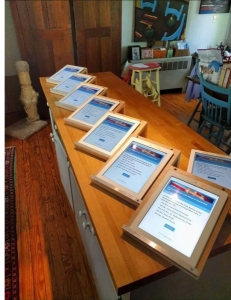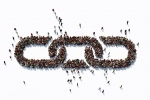November 11, 2016
Electronic Voting for Dioceses: What worked for us
 In April of 2016, I put out a request for help to the Episcopal Communicators Facebook group on best practices and recommendations for electronic voting at our bishop election convention in Central New York. As a way to say ‘thank you’ to this group, here’s what worked for us. (Click here for the related photos)
In April of 2016, I put out a request for help to the Episcopal Communicators Facebook group on best practices and recommendations for electronic voting at our bishop election convention in Central New York. As a way to say ‘thank you’ to this group, here’s what worked for us. (Click here for the related photos)
A response from Patrick Stroll in the Episcopal Diocese of Central Pennsylvania shared that they had contracted with a local school district to use their electronic voting system. As luck would have it, we had a school administrator on our Bishop Search Committee. Apparently New York has changed many of the laws around school voting, and he thought it unlikely that any school district would take the chance in renting out their electronic voting systems.
Another person on our team had taken a look at Simply Voting. While this appeared to be a reasonable system, many of their concerns (authentication, remote voting, assistance with ballot design, etc.) were not our concerns. We desired to have single use stations at the election convention with one use: voting for one of five people to be our next bishop.
I received a private Facebook message from Kate Carney Huston (Many thanks, Kate!), from Oklahoma, who gave me this suggestion:
“I'm assuming that you are thinking about computers at stations
since you mentioned having separate stations? You can do
something simple and inexpensive such as a Survey Monkey [survey]
(if you keep the link private and only open it for the time that
the voting is taking place then it takes care of a number of
security concerns that you might have).”
We assessed this solution, and selected SurveyMonkey as software to drive our system. At $26 a month, it was a bargain, even if it did not completely satisfy our requirements - more about this in a minute…
Next on the list: talking to our chancellor Paul Curtin, Esq. to see what he would say. This was a new voting system, and we wanted to insure it was would be within canonical rules. Among his concerns were the legal definition of a “vote,” tracking the results, and insuring the integrity of the election. While we could have used our own iPads (not hard to find, even just in our committee!), he insisted on clean iPads. SurveyMonkey allows the establishment of data “collectors” which we created for each iPad that we would use. This provided the ability to track individual voting stations and, using a sign-in list at the time of voting, insure that the result count of each individual voting station matched the voting list.
The SurveyMonkey data collec ted during the period of our election ballots would allow us to insure the integrity of the election, as it collected time stamps, IP addresses, and other pertinent data, which we could quickly utilize to check the vote. Our chancellor insisted that we collect an ordered list of the voters per iPad as a tracking method for the votes cast. One of our tellers wrote down each voter’s name before they entered the voting booth, and insured that the voter had cast a ballot afterwards.
ted during the period of our election ballots would allow us to insure the integrity of the election, as it collected time stamps, IP addresses, and other pertinent data, which we could quickly utilize to check the vote. Our chancellor insisted that we collect an ordered list of the voters per iPad as a tracking method for the votes cast. One of our tellers wrote down each voter’s name before they entered the voting booth, and insured that the voter had cast a ballot afterwards.
An important aspect of using SurveyMonkey was the capability to randomize each ballot at the time the election form was electronically loaded for a voter. This eliminated any “ballot position effect.” While studies indicate that such an effect is very small, we wanted to insure a fair election. For a general overview of the Ballot Position Effect, click here.
We quickly found that iPads could be rented for a reasonable rate, and in fact, the company we ended up renting from (flyingconnected.com) gave us a discount for nonprofit use, and even included a spare iPad in a sealed envelope as a backup. If we didn’t open the envelope, we didn’t pay for it. We created some simple stands for the iPads, at a cost of about $5 apiece. They were constructed from luaun plywood, with rubber feet to prevent sliding, and we anchored the iPads with an aluminum channel at the bottom of the stand and double sided tape behind the iPad. This gave us a portable platform in the event that any of our voters could not stand at the voting station and the slight incline of the stand presented an improved angle for voters to view the iPad screen. At the Election Convention, we would use small tables approximately 3.5 feet high, which would allow our voters to easily walk up to the voting station and cast their votes.
For the walkabouts for the diocese of the bishop candidates, we created a demo to show people how to vote in this new way. We quickly realized that while a touch screen device is natural for many people, for some it was difficult to lightly touch a single place on the screen to vote. We decided to equip all voting stations with a stylus to improve that aspect of interaction, and had youth standing by (as neutral parties to the election) to assist and to bring the iPad and stand down for anyone using a wheelchair. We also invited anyone who might have problems to bring a trusted friend along to assist them. Videos and printable instructions to explain the voting process were also created and Meredith Kadet Sanderson, communications specialist for the diocese, provided wonderful communications support to reach as many people as we could prior to the Convention.
The iPads were set up before the voting day by hiding all of the existing icons on the home screens in a single folder on the second iPad home screen, and then using safari to create an icon on the main home screen to directly bring up the SurveyMonkey ballot. Each iPad had a slightly different URL, which encoded the SurveyMonkey “collector” for that voting station. We also separated the clergy ballot from the lay ballot, although they were the same, to insure the 2 orders were accounted for separately.
To insure the very best visibility, we adjusted the screen brightness to the maximum level and set the color of the text on the voting screen to pure black from it’s original dark grey. Once a person had voted, our tellers were responsible for resetting the iPads by pressing the home button and then touching the SurveyMonkey icon on the screen to reload the next ballot.
After seeing the numbers of clergy and lay delegates who would vote, we decided on 3 clergy stations and 4 lay stations, hidden behind trifold screens for privacy. This would require each station be able to handle 30 to 40 voters, which seemed reasonable even if each voter took a minute to vote. The hope was that it would allow possibly 2 voters or more per minute. We also had a spare iPad standing by in case any of the voting stations had a problem. This was set up as the other stations, but with two icons on the home screen, one for the clergy ballot and one for the lay ballot. If we had needed it, we could have deleted the unneeded icon and replaced a malfunctioning iPad quickly. We had no technical issues, so this prepared iPad and the spare iPad in the envelope were not used at all.
Voting headquarters was set up in a secure room near our convention floor. We were fortunate to hold the convention in a hotel and the room we used for the electing convention had 4 Wifi routers, so the quality of the Internet connection and connectivity were no problem. We had tested the system before the election to insure that even if all the voting stations we used at the same time, the network bandwidth would be sufficient. In point of fact, little communication was actually taking place from/to the voting stations to the SurveyMonkey servers, but the testing validated that our communication plan would work as needed. Before the first round of voting, Charles Moore, one of the election co-chairs who oversaw the election, talked once more to everyone about the process. While we had great hopes that this system would work as expected, we also had paper ballots standing by, just in case.
And so the voting started.
The first round took approximately 40 minutes, which was expected, as this was a new system. The positive aspect of this was that after verifying the numbers of voters per voting station and checking that no electronic hacking had occurred, we had immediate results. SurveyMonkey’s summary results allowed us to do this check quickly and efficiently. We downloaded all of the data that SurveyMonkey had collected and formatted it and printed it off while the candidate’s shepherds were contacting their nominees. The first round resulted in 2 withdrawals, and the clergy and lay ballots were modified as needed by the technical support team in our voting headquarters in just seconds.
Round 2 started and was completed in about 21 minutes. We elected the 11th bishop of Central New York at this time. I feel confident that we could have done the next round in even less time, perhaps in the 15-minute range, but did not need to vote any further. The results were announced and we celebrated and went to lunch. Many voters were able to vote in 10 seconds or less, according to the SurveyMonkey data.
Feedback from the voters indicated that they liked the new system, liked the rapid results, and even liked standing in line for the voting stations, as they could talk with other voters and socialize. I personally feel that there is something in the touching of the nominees names as the voting method that is in keeping with the spiritual aspect of the process. The act of touching is integral to so much of our liturgy and our sacraments. The iPads allowed us to “touch” our next bishop into being, and somehow that seemed right and proper.
SurveyMonkey provided quick feedback when we ran into problems in the design/setup phase. Unfortunately, they usually responded with “That’s the way it works” or “That’s a good idea”. We increased the font size of the electronic election ballot to 24pt. Unfortunately the voting indicator, which preceded each name, did not increase in size, and was slightly misaligned with respect to the name. We felt strongly that it should be located on the baseline of the text rather than floating above the text on the line. Also, we were unable to increase the font size of text within the button for recording the vote as well, which would have been helpful.
There also was possible confusion after a person had voted and pressed the “Record Vote” button. There was insufficient feedback to indicate that the software was working. Even after the “Thanks for voting screen” appeared, there was a grey button saying “Record Vote” that merely took the voter to an ad page for SurveyMonkey (hey, for $26 a month, that’s what you get). We will be writing to them with various ideas and suggestions to improve their software, but it was usable for this voting process.
The messages to us were:
- Episcopal Communicators on Facebook is a GREAT place to get help!
- What we were doing was relatively simple, don’t overthink it
- The main benefit with electronic voting is in the counting and time to provide feedback
- Ballot creation with random positions for candidates is built in and important
- Almost instant updating of the ballot as needed for candidates who withdrew
- It works for a valid and fair election!
- It is scalable to larger or smaller audiences
For more information or if you have questions, don’t hesitate to contact me at j.andrew.pierce@gmail.com
Don't miss a blog post! Subscribe via email or RSS, using the grey box on the upper right.





